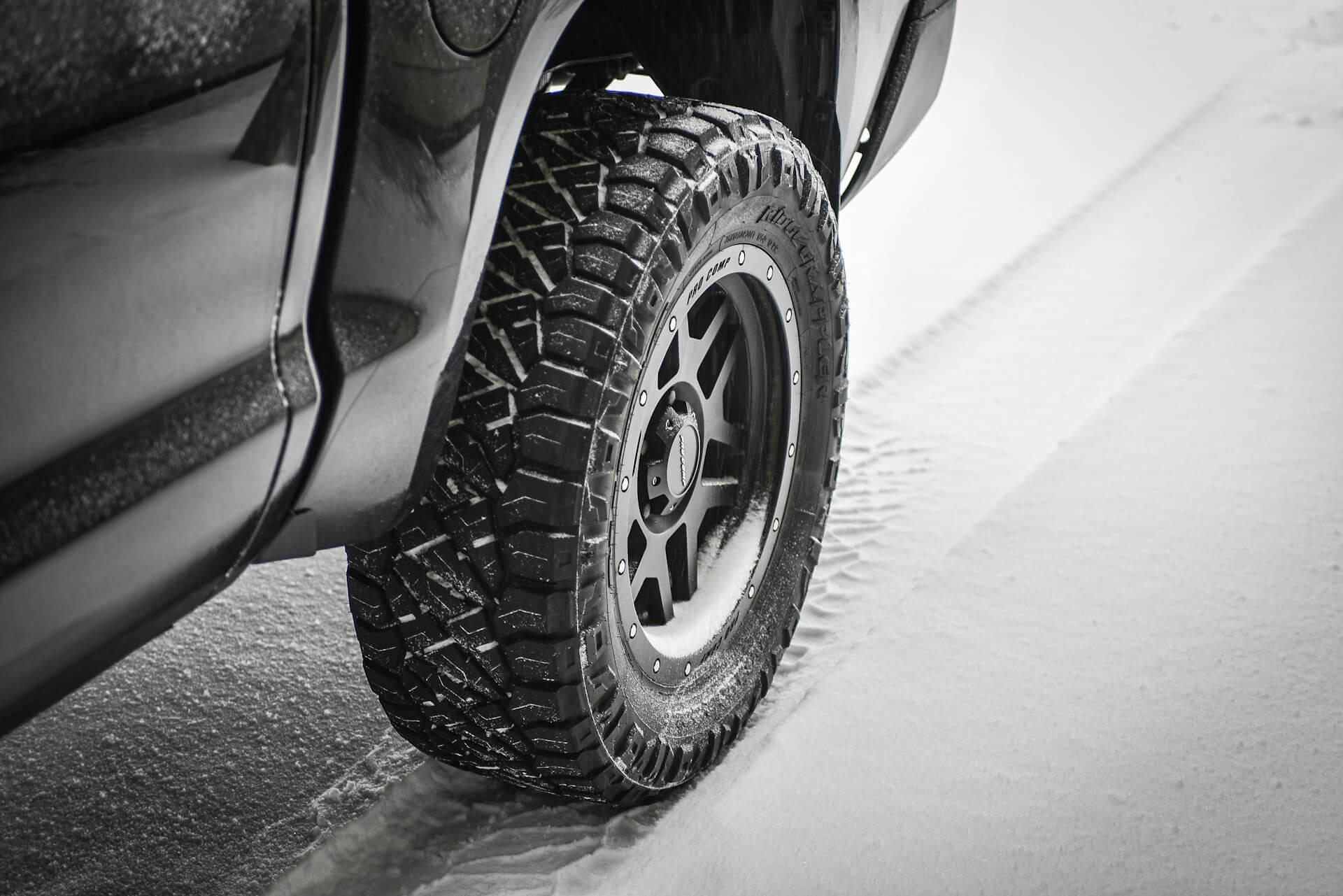22/03/2024

Winter tires
The importance of compulsory winter tires for road safety
It is well known that you have to change your tires twice a year. However, many people are annoyed by having to change their tires. Others wonder whether all-weather tires are a good alternative to the individual sets of winter or summer tires. And still others question the usefulness of the winter tire requirement itself. In this article, we address all these questions and show you what you need to bear in mind when using winter tires.
The need for compulsory winter tires
Mandatory winter tires are an essential factor for road safety. Winter tires improve grip on the road and shorten the braking distance on cold and wet surfaces, which significantly reduces the risk of accidents. This is particularly important in regions with harsh winters. Many people ask themselves whether all-weather tires are a good alternative in snow. All-weather tires can be a viable option in regions with mild winters, but tests show that specialized winter tires perform significantly better in low temperatures, snow and ice. It is and remains a fact that specialized tires prevent accidents and significantly increase safety in winter. Changing tires can therefore be a nuisance, but it can make all the difference in the event of an accident.
It should also be noted that there is no fixed winter tire requirement in the US for a specific period. Instead, having winter tires on is recommended. This is especially true for the states in the so-called winter tire belt, those being:
- Colorado
- Connecticut
- Delaware
- Idaho
- Illinois
- Indiana
- Iowa
- Maryland
- Massachusetts
- Michigan
- Minnesota
- Montana
- Nebraska
- New Hampshire
- New Jersey
- New York
- North Dakota
- Ohio
- Oregon
- Pennsylvania
- Rhode Island
- South Dakota
- Utah
- Vermont
- Washington
- Washington D.C
- West Virginia
- Wisconsin
- Wyoming
What to look out for when buying winter tires?
When buying winter tires, special attention should be paid to the 'M+S' markings for mud and snow as well as the Alpine symbol, a snowflake on a mountain. These indicate that the tire is suitable for winter conditions. However, the M+S symbol is only recognized until 30 September 2024 in certain countries and will then be completely replaced by the Alpine symbol. So as long as you have a snowflake in a mountain on your tire, everything is fine.
Choosing the right size and sufficient tread depth is also crucial. While the legal minimum tread depth is 0.3P in many countries, experts recommend a minimum tread depth of 0.9P for winter tires to ensure optimum driving characteristics on snow and ice. You can find more information in our article on tread depth.
It is also advisable to look for recommendations from trustworthy organizations, which regularly carry out tests and comparisons of winter tires to identify the best products for different conditions. We are also happy to help if you have any questions about the ideal tires for your car model.
Optimal storage of winter tires
The longevity of winter tires depends heavily on how they are stored. They should be stored in a dry, cool and dark place to protect them from the damaging effects of sunlight and high temperatures in summer. When storing tires on rims, it is advisable to hang them up or store them upright, while tires without rims are best stacked horizontally, with regular turning of the stacks helping to maintain the shape of the tires. Our article on this topic can also help you out.
Mandatory winter tires abroad?
While there is no precisely timed winter tire requirement in the US, the situation is different in some European countries. So before you set off on your winter vacation, you should find out about the prevailing conditions at your destination. Incidentally, all-weather tires also count as winter tires and are therefore affected by the winter tire requirement. You can find a brief summary of the regulations in different European countries for passenger cars in this table:
| Country | Regulation | Minimum profile-depth in P |
|---|---|---|
| Austria | Winter tires or snow chains are mandatory in winter conditions between 1.11. and 15.4. | 0.9 (radial tires) or 1.1 (diagonal tires) |
| Belgium, Denmark, United Kingdom, Netherlands, Poland | No general winter tire obligation. | - |
| Croatia | Winter tires are compulsory depending on the weather. | 0.9 |
| Czech Republic | Winter tires compulsory from 1.11. to 31.3. for vehicles weighing up to 3.5 tons. | 0.9 (cars with up to 3.5 metric tons of weight) and 1.4 (if more than 3.5 metric tons) |
| Estonia | Winter tires are mandatory from 1.11. to 31.3. Depending on the weather, the period can also be extended from October to April. | 0.7 |
| Finland | Winter tires compulsory from 1.11. to 31.3. | 0.8 are recommended |
| France | Winter tires are mandatory for Montan regions between 1.11. and 31.3. Alternatively, snow chains on the tires of the drive axle are possible, but then a maximum speed of 50 km/h applies. | 0.8 |
| Germany | Winter tires are mandatory depending on the weather. | 0.3 |
| Italy & South Tyrol | There is no uniform regulation here. Check the regulations in the provinces you want to drive in. | Depends on the province. |
| Latvia | Winter tires compulsory from 1.12. to 1.4. for vehicles weighing up to 3.5 tons. | 0.9 |
| Luxembourg | Winter tires are mandatory depending on the weather and apply to cars, but not to motorcycles, quads and light vehicles. | 0.3 |
| Norway | No winter tire obligation for vehicles weighing up to 3.5 tons, except in winter conditions. For vehicles weighing more than 3.5 tons, winter tires are mandatory from 15.11. to 31.3. | 0.7 (cars with up to 3.5 metric tons of weight) and 1.1 (if more than 3.5 metric tons) |
| Serbia | Winter tires compulsory from 1.11. to 1.4. | 0.9 |
| Slovakia | Winter tires are mandatory for cars weighing up to 3.5 tons, depending on the weather. For vehicles weighing more than 3.5 tons, winter tires are mandatory from 15.11. to 31.3. | 0.7 |
| Slovenia | Winter tires are mandatory from 15.11. to 15.3. and in winter conditions. | 0.7 |
| Sweden | Winter tires compulsory from 1.12. to 31.3. for vehicles weighing up to 3.5 tons. | 0.7 (cars with up to 3.5 metric tons of weight) and 1.1 (if more than 3.5 metric tons) |
| Switzerland | Winter tires are not compulsory, but fines can be imposed for accidents without winter tires in winter. | None |
Detection of winter tire wear
Regularly checking the tread depth and the general condition of the tires is crucial to ensure the safety and performance of winter tires. Special wear indicators in the tread make it easier to identify when a tire has reached the limit of its service life. Tires should also be inspected for signs of damage such as cracks, cuts or penetrating foreign objects. If you find cuts or dents, for example, you should definitely visit a garage. After all, winter tires are mandatory for safety and the condition of your winter tires is essential for this purpose.
Conclusion
Appropriate selection and care of winter tires is crucial for road safety during the cold months. The risk of accidents can be significantly reduced by complying with winter tire regulations and following the recommendations of professional organizations such as the ADAC. Although all-weather tires can be a practical alternative in certain conditions, the use of specialized winter tires is essential in areas with harsh winters. Careful handling and regular maintenance not only contribute to safety, but also to the overall improvement of road safety.
In summary, it is understandable if you don't want to change your tires every few months. However, the winter tire requirement serves to improve safety, not only for yourself, but also for other road users. In addition, changing the tires is a good opportunity to clean the wheels, which is good for their longevity. So if you want to drive safely, stick to the rule of thumb "O to E"; drive with winter tires from October to Easter.























